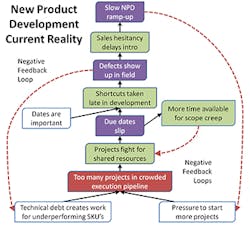If you’ve ever worked in marketing or been on the buying side, you know that building trust or overcoming skepticism is a key part of selling any new product. What you might find surprising though is that many organizations face that same skepticism internally thereby hiding significant innovation capacity.
I’ve run into this situation across several different industries, but the first time was with a high tech industrial client that was looking to accelerate time to market. Shortly after starting to work together, I discovered that their new product plans always showed zero sales for 18-24 months after production scale up. That seemed like a lengthy buying cycle for their market, so I inquired if it had anything to do with customers having to evaluate the product and test it in their systems. I was surprised to learn that wasn’t the reason. In fact, once the sales channel began quoting a new product, orders would begin flowing in within 3-6 months.
The issue was that the sales channel simply didn’t trust engineering and wouldn’t begin promoting the product with any major accounts until it had been out in the field for at least 1 to 2 years. So we mapped out their dilemma using a Theory of Constraints thinking tool called the Current Reality Tree. The logic is shown in the graphic but flows as follows.
New product sales were taking take too long to ramp up due to the sales channel hesitancy. The channel was hesitant because it did not trust engineering to launch a robust product after a history of field failures over the last few years. The failures had escaped because shortcuts were taken in some of the later stages of the project involving technical verification, testing and manufacturing scale up. The shortcuts were deemed necessary because the projects had already missed their initial due dates.
As always, there were numerous reasons for the delay. But the primary issue was that projects regularly ended up waiting for shared resources. That led us to the root cause - allowing too much work in process (WIP) given the execution resources available. (See our Growth Equation article Industry Week series for a demonstration of the impact of new product WIP)
There were also several negative feedback loops holding the company’s root cause in place. First, the slow sales ramp up encouraged the group to push even more work into execution. Second, the technical debt from field failures spawned numerous improvement projects for engineering. Both of these pushed more work into execution further aggravating the shared resource wait. Additionally, the resulting long project durations invited scope creep from product managers that had extra time to uncover desirable new features.
As we saw, the problem boiled down to mistrust. But ultimately, it takes a leap of trust to limit WIP and break the negative cycle in situations like this. The product development organization has to install the discipline of WIP control - all the while knowing that someone will be screaming that their project has not started. After getting WIP under control, they organization begins to see they can actually launch more products and will be able to commit to and meet launch due dates.
Most importantly, with faster execution and more realistic due dates, those debilitating shortcuts won’t be so tempting. By avoiding that technical debt, you break the cycle of mistrust and give the sales team the confidence needed to begin quoting sooner thereby shortening time to revenue.
Looking to uncover hidden new product capacity for your organization? Download the Growth Equation Diagnostic from Mike Dalton's Guided Innovation Group to see what kind of improvements you can make.





